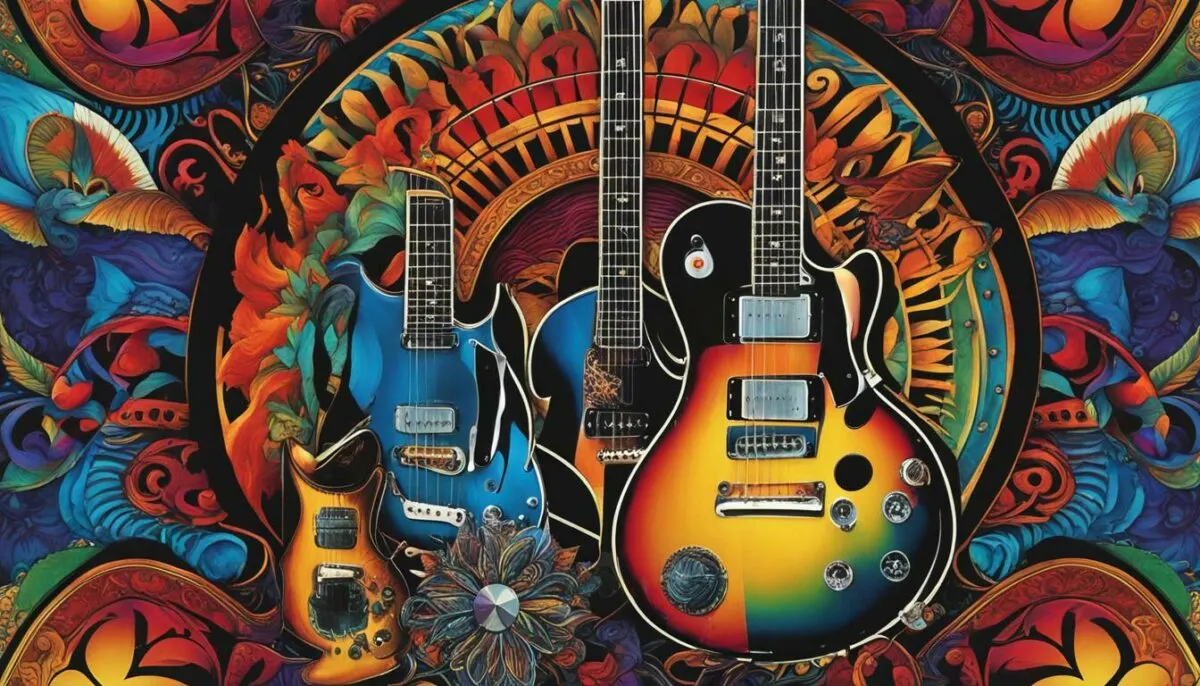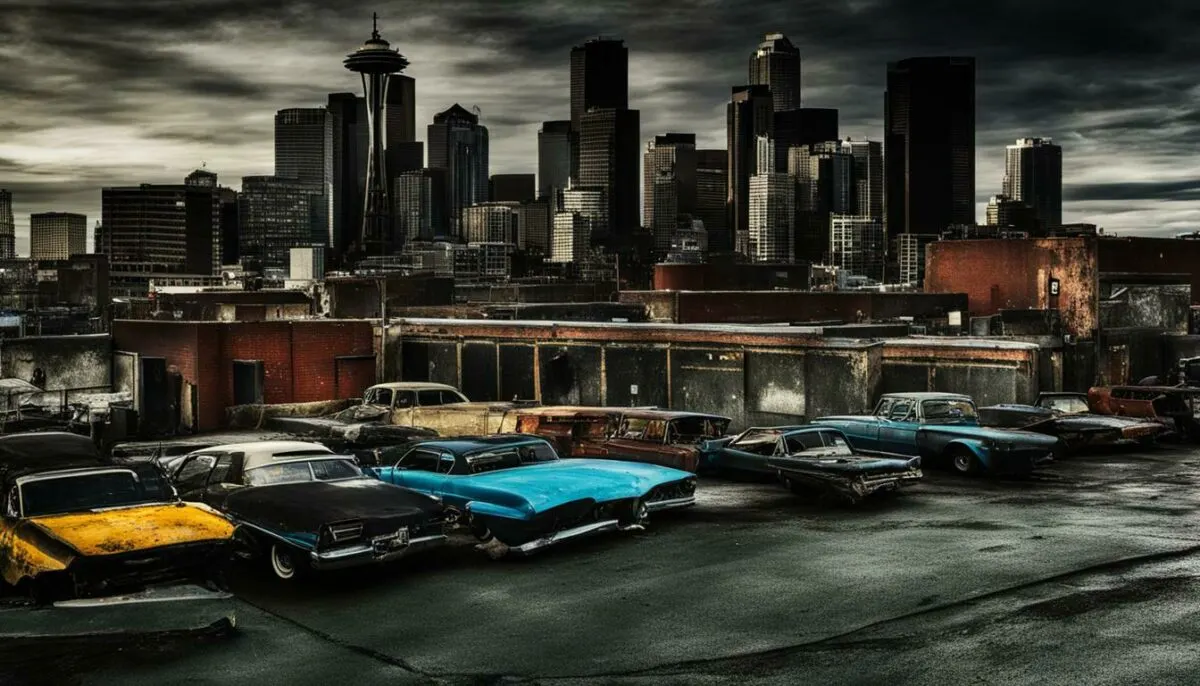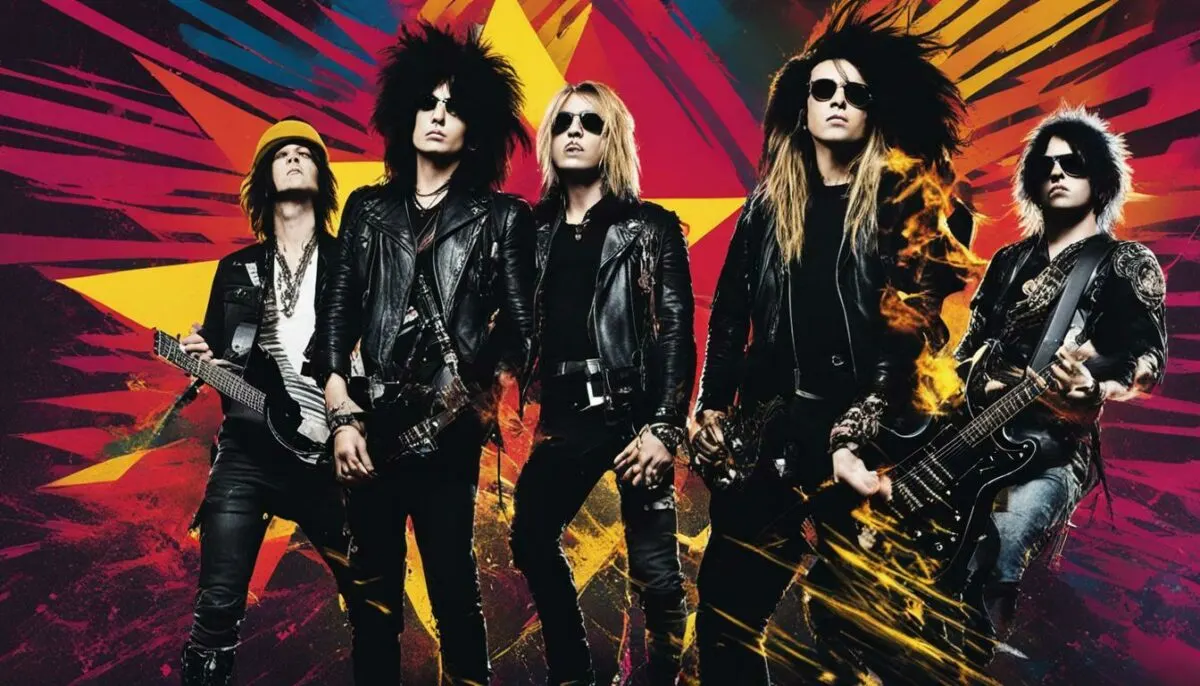Rock music has been a cultural phenomenon for decades, captivating audiences with its raw energy, powerful lyrics, and iconic sounds. Over the years, numerous genres and subgenres have emerged, ranging from classic rock to alternative rock, punk rock to heavy metal, and everything in between.
In this comprehensive guide, we will take a closer look at the different types of rock music, exploring the various genres and subgenres that fall under this exciting musical category. From the origins of rock and roll to modern rock fusion, we’ll cover it all.
Key Takeaways:
- Rock music encompasses a wide range of genres and subgenres.
- Some popular rock music styles include classic rock, heavy metal, and alternative rock.
- Subgenres of rock include punk rock, grunge, psychedelic rock, and more.
- Different rock music categories offer distinct sounds, attitudes, and cultural influences.
- Rock music has had a lasting impact on popular culture, fashion, and music in the United States and around the world.
The Origins of Rock and Roll
Rock and roll music has a rich history that spans over six decades. It emerged in the United States in the 1950s and quickly gained popularity among young people who were looking for new, exciting sounds to dance to.
The term “rock and roll” was coined by radio disc jockey Alan Freed, who played rhythm and blues music on his radio show. Rhythm and blues was a genre of music that originated in African American communities and combined jazz, blues, and gospel music.
Rock and roll music was heavily influenced by rhythm and blues, as well as country and western music. It featured upbeat tempos, catchy melodies, and electric guitars, which gave it a distinctive sound that was different from anything that had come before it.
One of the first rock and roll songs to gain national attention was “Rock Around the Clock” by Bill Haley and His Comets. The song became an instant hit and helped to launch the rock and roll movement into the mainstream.

Rock and roll music continued to evolve throughout the 1960s and 1970s, with the emergence of subgenres like psychedelic rock, hard rock, and heavy metal. These subgenres expanded on the sound and style of rock and roll, incorporating new instruments, techniques, and themes.
Today, rock and roll music continues to be popular among music fans of all ages, with classic rock radio stations playing hits from the 60s, 70s, and 80s, and new bands pushing the boundaries of the genre with their own unique sounds.
Classic Rock: The Soundtrack of a Generation
When it comes to rock music, there are few genres as iconic and influential as classic rock. This style of music emerged in the late 1960s and early 1970s, characterized by its heavy use of electric guitar, powerful vocals, and driving rhythms.

Classic rock music styles are often associated with the counterculture movement of the 1960s and 1970s, which rejected mainstream values and embraced experimentation and individuality. Bands such as The Beatles, Led Zeppelin, and The Rolling Stones became the soundtrack for a generation, with their music serving as a voice for social and political change.
Many classic rock bands also explored themes of love, freedom, and rebellion through their music, resonating with audiences who were seeking a new form of expression. Their music was often characterized by intricate guitar solos, complex harmonies, and anthemic choruses, creating a sound that was both powerful and emotive.
Today, classic rock remains a popular genre of music, with many of the original bands still performing and influencing new generations of musicians. From the classic rock radio stations to the concert venues, the sounds of classic rock continue to endure, inspiring and entertaining fans around the world.
Hard Rock: Raw Power and Energy
Hard rock is a genre of rock music that emerged in the late 1960s and continues to influence music today. Characterized by heavy guitar riffs, powerful vocals, and an aggressive sound, hard rock music styles have inspired generations of rock fans around the world.
Some of the most popular hard rock bands include AC/DC, Led Zeppelin, and Van Halen. These bands, along with many others, have helped define the genre and create a signature sound that continues to resonate with fans worldwide.

Hard rock music styles have also given rise to several subgenres, including metal, punk, grunge, and alternative rock. These subgenres build on the foundation of hard rock and add new elements, creating a diverse and dynamic genre with many different variations.
One of the defining characteristics of hard rock is its raw power and energy. From the thunderous drumming to the screaming guitars, hard rock is all about intensity and excitement. This genre is often associated with rebellion and a non-conformist attitude, making it popular among young people looking for an outlet for their emotions.
Overall, hard rock is a genre that continues to evolve and inspire new generations of fans. Whether you’re a fan of classic hard rock or one of its many subgenres, this genre has something for everyone who loves music with power, energy, and attitude.
Soft Rock: Smooth Melodies and Mellow Vibes
If you’re looking for a more laid-back sound within the rock genre, soft rock might be just what you need. Characterized by its gentle melodies and mellower vibes, this subgenre of rock music emerged in the late 1960s and early 1970s as a response to the heavier sounds of hard rock and heavy metal.
Soft rock often features acoustic instruments, such as guitars and pianos, and focuses on introspective lyrics and emotional themes. Some of the most popular soft rock bands include Fleetwood Mac, The Eagles, and America.
One of the defining characteristics of soft rock is its ability to blend with other genres, resulting in a variety of subgenres such as folk rock, country rock, and pop rock. The versatility of soft rock has made it a popular choice for romantic ballads and easy-listening radio stations.

Overall, soft rock offers a relaxing and satisfying listening experience that is perfect for winding down after a long day or enjoying a peaceful drive. Its blend of acoustic instruments, emotional lyrics, and gentle melodies make it one of the most unique and diverse genres within the rock music family.
Alternative Rock: Breaking Boundaries
Alternative rock emerged as a distinct voice in the 1980s, challenging the mainstream norms of rock music and paving the way for new sounds and styles. This genre is known for its eclectic mix of influences, from punk and post-punk to psychedelic and grunge, resulting in a diverse range of subgenres and styles.
Some of the most notable alternative rock subgenres include:
| Subgenres | Description |
|---|---|
| Grunge | A subgenre that emerged from Seattle in the 1990s, characterized by its raw, distorted sound and introspective lyrics. |
| Indie | An independent-minded subgenre that emphasizes individuality, creativity, and non-commercialism. |
| Britpop | A subgenre that emerged in the UK during the 1990s, characterized by its catchy hooks and melodic sound. |
| Shoegaze | A dreamy and atmospheric subgenre that emphasizes texture and layers of sound. |
| Post-rock | An experimental subgenre that utilizes unconventional song structures and instrumentation. |
Alternative rock also includes many different genres that have their own unique characteristics, such as emo, goth, and industrial. This diversity is what sets alternative rock apart from other genres and has made it a favorite among music fans who value creativity and individuality.

Whether you’re a fan of grunge, indie, or any of the other alternative rock subgenres, there’s no denying the impact that this genre has had on the music world. So take some time to explore the many different alternative rock genres and subgenres, and discover your new favorite band today!
Punk Rock: Rebellion and Raw Energy.
Punk rock emerged in the mid-1970s as a response to the commercialization of rock music, with its fast-paced, aggressive sound and rebellious attitude. This genre was characterized by its raw energy, DIY ethos, and politically charged lyrics that challenged societal norms.
Punk rock has gone through several variations over the years, including hardcore punk, pop punk, and post-punk, among others. Hardcore punk was a more extreme version of punk rock, featuring faster tempos and harsher vocals. Pop punk, on the other hand, incorporated elements of pop music, with catchy melodies and upbeat rhythms. Post-punk was a more experimental and artistic variation of punk rock.
Punk rock also had a significant impact on fashion, with its anti-establishment attitude reflected in the torn clothes, leather jackets, and mohawk hairstyles of its followers. The genre’s influence can still be seen today, with punk rock bands and fashion remaining relevant and popular around the world.

“Punk rock is not just about the music, it’s about the message. It’s about standing up against the system and making your voice heard.” – Joe Strummer
Heavy Metal: Power, Precision, and Intensity
Heavy metal music types are known for their thunderous sound, intricate guitar solos, and powerful vocals. This genre pushes the boundaries of musical intensity and technicality and has been a popular form of rock music since the 1970s. Heavy metal is characterized by its aggressive sound and lyrics that often explore themes of defiance, rebellion, and even occultism.
Heavy metal features several subgenres, each with its own unique sound and style. Some of the most popular metal music types include:
| Subgenre | Description |
|---|---|
| Thrash metal | Fast and intense, with complex guitar riffs and aggressive vocals. Bands like Metallica and Slayer helped popularize this subgenre in the 1980s. |
| Death metal | Known for its guttural vocals and heavy use of double-bass drumming. Bands like Cannibal Corpse and Death are pioneers of this subgenre. |
| Black metal | Focused on dark, atmospheric soundscapes and lyrics that often deal with Satanism and the occult. Bands like Mayhem and Burzum are among the most influential in this subgenre. |
| Power metal | Characterized by its use of soaring vocals and melodic guitar lines, this subgenre often features fantasy or historical themes in its lyrics. Bands like Helloween and Blind Guardian are staples of the power metal scene. |
| Doom metal | Slow and heavy, with an emphasis on atmospheric soundscapes and morbid lyrical themes. Bands like Black Sabbath and Candlemass helped establish this subgenre in the 1970s. |
Despite its often aggressive and dark sound, heavy metal music types have a dedicated and passionate fan base that spans generations. From classic bands like Iron Maiden and Judas Priest to contemporary acts like Mastodon and Ghost, heavy metal continues to be a vital and exciting part of the rock music landscape.

The grunge movement was an underground subculture that originated in Seattle, Washington during the late 1980s and early 1990s. This genre of music is characterized by its distorted guitar riffs, heavy drums, and introspective lyrics.
Grunge music is often associated with iconic bands such as Nirvana, Pearl Jam, and Soundgarden, who helped to popularize this style of music and introduce it to a broader audience.
One of the defining characteristics of grunge music is its raw, unpolished sound, which served as a rejection of the overproduced and commercialized music that dominated the airwaves at the time.
Despite the negative connotations associated with the term “grunge,” this subgenre of rock music showcased a new level of creativity and individuality that captured the attention of music fans around the world.

The grunge movement also coincided with the rise of “alternative rock,” which offered a more diverse and experimental sound than traditional rock music. This allowed for a variety of subgenres within the grunge movement, including “early grunge,” which emphasized punk rock influences, and “post-grunge,” which incorporated more pop elements into the music.
The legacy of grunge music continues to this day, with many contemporary artists citing it as a major influence. Its impact can be seen in the resurgence of heavy, distorted guitar sounds in modern rock music, as well as in the continued popularity of bands like Nirvana and Pearl Jam.
Indie Rock: DIY Spirit and Artistic Freedom
Indie rock, short for independent rock, is a genre that emphasizes individuality, creativity, and non-commercialism. It emerged in the 1980s and gained popularity in the 1990s, with bands such as Sonic Youth, Pavement, and Neutral Milk Hotel.
What sets indie rock apart from other types of rock music is its DIY spirit. Many indie rock bands self-produce their music, record their albums in home studios, and release their music through their own independent labels rather than signing on with major record labels. This gives them artistic freedom, allowing them to experiment with their sound and lyrics without being constrained by commercial pressures.
Indie rock variations range from lo-fi to post-punk and from folk to shoegaze. Some notable subgenres include emo, math rock, and twee pop. Emo, short for emotional hardcore, is characterized by confessional lyrics and expressive vocals. Math rock is a complex and experimental style that emphasizes intricate rhythms and unconventional time signatures. Twee pop, on the other hand, features jangly guitars, sweet melodies, and whimsical lyrics.

Indie rock bands often draw inspiration from a wide range of musical styles, including punk, folk, and grunge. They also incorporate a DIY aesthetic into their live shows, often playing in intimate venues, such as basements and small clubs.
Despite their non-commercial approach, many indie rock bands have achieved mainstream success, such as The Strokes, Arcade Fire, and Vampire Weekend. However, they have managed to maintain their independent spirit and unique sound, which continues to attract fans who appreciate their artistic integrity and authenticity.
Indie rock’s DIY ethos and artistic freedom have made it a significant force in the music industry, inspiring generations of musicians to follow their own path and pursue their creative vision. If you’re looking for a genre that celebrates individuality and creativity, indie rock is definitely worth exploring.
Psychedelic Rock: Mind-Bending Sounds and Trippy Atmospheres
Psychedelic rock emerged during the counterculture movement of the 1960s and combined elements of rock and roll with experimental sounds, trippy atmospheres, and mind-bending lyrics. This genre was heavily influenced by the use of psychedelic drugs, which were thought to enhance creativity and expand consciousness.
Some of the defining features of psychedelic rock include distorted guitar sounds, intricate vocal harmonies, and the use of unconventional instruments like sitars, mellotrons, and theremins. Bands like The Beatles, Pink Floyd, and The Doors were at the forefront of the psychedelic rock movement, and their music continues to inspire artists today.

Psychedelic rock also spawned several subgenres, including acid rock, space rock, and psychedelic folk. Acid rock placed a greater emphasis on heavy distortion and improvisation, while space rock leaned towards a more ambient sound with sci-fi themes.
Psychedelic folk, on the other hand, blended traditional folk music with psychedelic elements, resulting in a dreamy, ethereal sound. Bands like Jefferson Airplane, The Byrds, and The Grateful Dead were instrumental in popularizing psychedelic folk, paving the way for future artists like Devendra Banhart and Joanna Newsom.
Psychedelic rock has had a lasting influence on rock and roll subgenres, with bands like Tame Impala and Unknown Mortal Orchestra carrying on the tradition of incorporating experimental sounds and trippy atmospheres into their music.
Glam Rock: Exuberance, Fashion, and Theatrics
Glam rock, also known as glitter rock, emerged in the early 1970s and became wildly popular throughout the decade. This subgenre of rock music was characterized by its theatricality, flamboyant fashion, and exuberant performances. While it was often criticized for its focus on style over substance, glam rock left an indelible mark on the world of rock music and inspired countless musicians to push artistic boundaries.
One of the defining features of glam rock was its over-the-top fashion sense. The musicians who played this style of rock were known for their platform shoes, sparkly outfits, and bold makeup. They often sported long hair and androgynous looks, blurring the lines between gender norms and expectations. This focus on fashion and image was a reaction to the more politically charged music of the late 1960s and early 1970s, providing a fun and lighthearted escape for fans and artists alike.
| Key Characteristics of Glam Rock | Notable Glam Rock Artists |
|---|---|
|
|
Glam rock also introduced a new level of showmanship to the world of rock music. Musicians in this genre were known for their elaborate stage shows, which featured pyrotechnics, special effects, and other forms of visual spectacle. David Bowie, one of the most famous glam rock artists, famously adopted the persona of Ziggy Stardust, a flamboyant and otherworldly character that he embodied both on stage and off.
Another hallmark of glam rock was its emphasis on catchy, anthemic songs that were easy to sing along to. Many of the songs from this era have become classics, still enjoyed by fans today. From T. Rex’s “Bang a Gong (Get It On)” to Queen’s “We Will Rock You,” glam rock produced some of the most beloved songs of the 1970s.

In conclusion, glam rock may have been criticized for its focus on image and style, but it also represented a new form of artistic expression in the world of rock music. From David Bowie’s theatricality to Queen’s epic anthems, glam rock captured the imagination of fans and inspired countless musicians to experiment with new sounds and styles. Today, it remains an important part of the classic rock canon and a testament to the power of creativity and self-expression.
Contemporary Rock: Evolution and Fusion
Rock music has continued to evolve and merge with other genres, giving rise to new and exciting sounds. Contemporary rock genres are a testament to the rich history of rock music and the fusion that has occurred between different styles. Contemporary rock is not a single genre but an umbrella term that encompasses various rock music classifications.
From post-grunge to pop punk, contemporary rock has something for everyone. One popular contemporary rock genre is indie rock, which emphasizes individuality, creativity, and non-commercialism. Indie rock bands often incorporate elements of other genres into their music, such as folk, blues, and electronic music.
Another contemporary rock subgenre is post-punk revival, which has its roots in the punk rock movement of the 1970s. Post-punk revival bands often incorporate elements of new wave, alternative rock, and post-punk into their sound, creating a unique blend of genres.
Contemporary rock is also characterized by its fusion with other genres such as rap, hip hop, and electronic music, leading to the emergence of subgenres like rap rock, nu metal, and electronic rock.
| Contemporary Rock Genres | Description |
|---|---|
| Indie Rock | Emphasizes individuality, creativity, and non-commercialism. |
| Post-Punk Revival | Fuses elements of new wave, alternative rock, and post-punk. |
| Rap Rock | Fuses rap and rock music, characterized by its heavy beats and aggressive lyrics. |
| Nu Metal | Fuses heavy metal with other genres such as hip hop, funk, and industrial music. |
| Electronic Rock | Fuses rock music with electronic music, characterized by its use of synthesizers and other electronic instruments. |
Contemporary rock has been able to evolve and adapt to changing musical trends and technology, ensuring its continued relevance in the music industry. As rock music continues to evolve and fuse with other genres, we can expect to see the emergence of new and exciting sounds that push the boundaries of musical expression.

Rock music is a genre that has evolved and expanded over time, giving rise to numerous types of rock genres and different styles of rock music. From classic rock to alternative rock, punk rock to heavy metal, each genre has its own distinctive sound and character.
One of the most popular subgenres of rock music is classic rock, which features iconic bands such as Led Zeppelin, The Rolling Stones, and The Beatles. Classic rock is known for its catchy hooks, timeless melodies, and guitar-driven sound.
Another subgenre of rock music is heavy metal, which is characterized by its fast-paced rhythms, intricate guitar solos, and intense vocals. Some of the most well-known heavy metal bands include Metallica, Iron Maiden, and Judas Priest.
Alternative rock emerged in the 1980s as a response to the mainstream music scene, offering a fresh, new sound that challenged conventional norms. Alternative rock includes subgenres such as grunge, indie rock, and post-punk revival, among others.
Punk rock, another subgenre of rock music, emerged in the 1970s as a reaction to the social and political issues of the time. Punk rock is known for its raw, fast-paced sound, rebellious attitude, and anti-establishment lyrics.
Soft rock, on the other hand, emphasizes gentle melodies and easy-listening vibes. Soft rock artists include Fleetwood Mac, Phil Collins, and Elton John.
Glam rock features flamboyant fashion, theatrical performances, and catchy, anthemic songs. David Bowie, Kiss, and Queen are some of the most well-known glam rock artists.
The indie rock genre is characterized by its independent spirit, DIY ethos, and unique, experimental sound. Indie rock bands include Arcade Fire, Radiohead, and Vampire Weekend, among others.
Psychedelic rock emerged during the counterculture movement of the 1960s, and is known for its mind-bending sounds, trippy atmospheres, and experimental vibes. The Beatles, Pink Floyd, and The Doors are some of the most popular psychedelic rock artists.
Contemporary rock is a genre that continues to evolve and fuse with other musical styles, such as electronic dance music (EDM), hip-hop, and pop. Some contemporary rock artists include The Black Keys, Imagine Dragons, and Coldplay, among others.
With so many types of rock genres and different styles of rock music to choose from, it’s no wonder that rock music continues to be a popular genre that resonates with music fans of all ages and backgrounds.

Over the decades, rock music has undeniably had a significant impact on popular culture, fashion, and music. Its evolution and diversity have undoubtedly contributed to its lasting influence.
Defining rock and its subgenres can be a challenging task, as it encompasses such a broad range of styles and sounds. Still, the genre’s ability to adapt, grow, and influence other musical genres has sustained its relevance even today. Rock music has evolved from its roots in the blues, jazz, and country music into a distinct, recognizable sound of its own.
The 1960s saw the emergence of psychedelic rock, a genre that challenged mainstream norms and emphasized experimentation and mind-bending sounds. At the same time, the punk rock movement of the 1970s pushed the boundaries of musical aggression and rebellion, inspiring the DIY spirit and anti-establishment ethos that still characterizes much of the underground rock scene today.
The 1980s saw the rise of glam rock, with its glitzy fashion, theatrical performances, and catchy, anthemic tunes. Heavy metal also continued to thrive during this decade, evolving with new subgenres like thrash metal and hair metal.
Alternative rock emerged in the 1990s, with bands like Nirvana and Pearl Jam paving the way for a new sound that blended punk rock influences with introspective lyrics and a raw, emotional sound. Grunge, a subgenre of alternative rock, gained popularity with bands like Soundgarden, Alice in Chains, and of course, Nirvana.
Today, rock music continues to evolve and influence other genres, with artists experimenting with new sounds, styles, and techniques to push the boundaries of what rock music can be. From indie rock to post-punk revival, the diversity of rock music is a testament to its enduring influence and lasting impact on music as a whole.

As we’ve explored the different types of rock music and its lasting influence, it’s clear that this genre has cemented its place in music history. Its diverse sounds and styles have inspired countless musicians, and its influence can still be heard in the music we listen to today. Whether you’re a fan of classic rock, heavy metal, punk rock, or any other subgenre, rock music has something for everyone. So turn up the volume, and let the power of rock music move you!
Conclusion
In conclusion, rock music offers a diverse range of genres and subgenres, each with its own unique sound and characteristics. Whether you prefer the iconic sounds of classic rock, the raw energy of hard rock and punk rock, or the introspective melodies of grunge and soft rock, there is something for everyone in the world of rock music.
The influence of rock music has had a lasting impact on popular culture, fashion, and music today. From the birth of rock and roll to the emergence of new and exciting contemporary rock genres, this genre has evolved and fused with other musical styles, resulting in some of the most groundbreaking and innovative sounds of our time.
So, whether you are a lifelong fan or just getting into rock music, take some time to explore the different types of rock music and discover your own favorite genre. With its powerful rhythms, emotive lyrics, and unforgettable performances, rock music will continue to captivate audiences for generations to come.
FAQ
Q: What are the different types of rock music?
A: Rock music encompasses various genres and subgenres, including classic rock, hard rock, soft rock, alternative rock, punk rock, heavy metal, grunge, indie rock, psychedelic rock, glam rock, and more.
Q: What is the origin of rock and roll?
A: Rock and roll originated in the United States in the 1950s, combining elements of rhythm and blues, country music, and gospel. It is considered the precursor to the diverse genres of rock music we know today.
Q: What defines classic rock?
A: Classic rock refers to the popular rock music styles from the 1960s, 1970s, and early 1980s. It is characterized by its anthemic nature, memorable guitar riffs, and influential bands such as Led Zeppelin, The Rolling Stones, and The Beatles.
Q: What is the sound of hard rock?
A: Hard rock is known for its raw, powerful sound, featuring heavy guitar riffs, aggressive vocals, and energetic performances. Bands like AC/DC, Guns N’ Roses, and Black Sabbath are prominent in this genre.
Q: What is soft rock?
A: Soft rock, also known as light rock, is a subgenre of rock music that incorporates gentle melodies, smooth vocals, and a mellow vibe. Artists such as Elton John, Fleetwood Mac, and The Eagles are associated with this style.
Q: What is alternative rock?
A: Alternative rock emerged in the 1980s as a subculture of rock music, challenging mainstream norms with its unique sound and independent spirit. It encompasses various subgenres like grunge, indie rock, and Britpop.
Q: What defines punk rock?
A: Punk rock emerged in the 1970s as a rebellious and aggressive genre, characterized by fast-paced music, raw energy, and socially and politically charged lyrics. Bands like The Ramones, Sex Pistols, and The Clash are notable in this genre.
Q: What is heavy metal?
A: Heavy metal is a genre known for its powerful sound, intense guitar solos, and often dark or aggressive lyrics. Bands like Metallica, Iron Maiden, and Black Sabbath are influential in this genre.
Q: What is grunge?
A: Grunge is a genre that emerged in the 1990s from the Seattle music scene. It is characterized by its distorted sound, angsty lyrics, and non-conformist attitude. Bands like Nirvana, Pearl Jam, and Soundgarden popularized grunge.
Q: What is indie rock?
A: Indie rock, short for independent rock, is a genre that emphasizes artistic freedom, non-commercialism, and a DIY (do-it-yourself) ethic. It encompasses a wide range of sounds and subgenres, often associated with independent or underground music scenes.
Q: What is psychedelic rock?
A: Psychedelic rock emerged in the 1960s, influenced by the counterculture movement and characterized by its mind-bending sounds, experimental arrangements, and trippy atmospheres. Bands like The Beatles, Pink Floyd, and The Doors embraced this genre.
Q: What is glam rock?
A: Glam rock is a genre known for its exuberant and flamboyant performances, theatricality, and catchy, anthemic songs. It emerged in the 1970s and was popularized by artists like David Bowie, T. Rex, and Queen.
Q: How has rock music evolved in contemporary times?
A: Rock music has continued to evolve and fuse with other genres in contemporary times. It has given rise to subgenres and experimental sounds, often blending elements of electronic music, hip-hop, pop, and more.
Q: What are the different categories of rock music?
A: Rock music encompasses a diverse range of genres and subgenres, including classic rock, hard rock, soft rock, alternative rock, punk rock, heavy metal, grunge, indie rock, psychedelic rock, glam rock, and many more.
Q: How has rock music influenced popular culture?
A: Rock music has had a lasting impact on popular culture, influencing fashion, attitudes, and musical trends. It continues to be celebrated and embraced by fans worldwide.